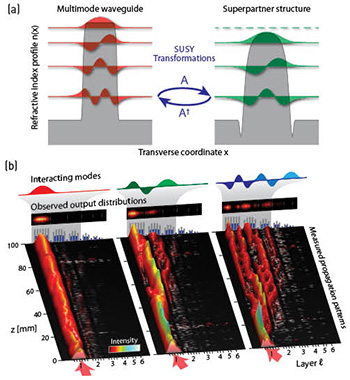 (a) Supersymmetric (SUSY) transformation between optical waveguides. The mode sets of the original structure and its superpartner are globally phase-matched, while the fundamental mode is removed. SUSY transformations relate spatial profiles of the paired modes to one another. (b) Experimental observation of mode conversion in SUSY photonic lattices.2 The content of higher modes in the fundamental layer is transformed to lower modes by evanescent coupling to the adjacent superpartner.
(a) Supersymmetric (SUSY) transformation between optical waveguides. The mode sets of the original structure and its superpartner are globally phase-matched, while the fundamental mode is removed. SUSY transformations relate spatial profiles of the paired modes to one another. (b) Experimental observation of mode conversion in SUSY photonic lattices.2 The content of higher modes in the fundamental layer is transformed to lower modes by evanescent coupling to the adjacent superpartner.
The idea of supersymmetry (SUSY) was conceived within the framework of quantum field theory as a means to treat bosons and fermions on equal footing. While SUSY verification remains an ongoing task, some of its fundamental notions have been adapted to other fields. Optics can provide a versatile platform where SUSY transformations can be studied and directly observed.1,2 One of the most interesting consequences of this symmetry is the ability to provide global phase-matching conditions: When related via a SUSY mapping, two seemingly different refractive index (RI) distributions exhibit modes with pairwise identical propagation constants, while the fundamental mode is removed in the partner structure.
This unusual feature gives rise to a variety of potential applications in integrated optics. In particular, hierarchical sequences of SUSY multimode waveguides can be utilized for passive, yet highly efficient mode conversion. Making use of photonic lattice arrangements, we directly observed SUSY phase matching and mode conversion in SUSY optical structures.2 Such arrangements could provide the building blocks for next-generation on-chip photonic interconnects that utilize multimode waveguides for spatial division multiplexing, while maintaining compatibility to existing multiplexing techniques.
Optical SUSY can be readily extended to accommodate gain and loss, and may serve to identify new families of non-Hermitian RI landscapes with entirely real-valued spectra, and can even be employed to restore spontaneously broken parity-time symmetry.3 Finally, SUSY concepts can be used to synthesize reflectionless arrangements,4 and give rise to a new class of transformation optics.5 By systematically eliminating all bound states, dielectric arrangements with a low RI contrast can be designed to mimic the scattering behavior of high-contrast structures. Similar strategies could be adopted to replace negative-permittivity domains, thus averting optical losses.
It will be interesting to explore the effects afforded by SUSY optics, and to see how SUSY ideas and functionalities can be incorporated into integrated-photonic platforms.
Researchers
Matthias Heinrich, Mohammad-Ali Miri and Demetrios N. Christodoulides, CREOL The College of Optics and Photonics, University of Central Florida, USA
Simon Stützer, Stefan Nolte and Alexander Szameit, Institute of Applied Physics, Friedrich-Schiller-University, Jena, Germany
References
1. M.-A. Miri et al. Phys. Rev. Lett. 110, 233902 (2013).
2. M. Heinrich et al. Nat. Commun. 5, 3698 (2014).
3. M.-A. Miri et al. Phys. Rev. A 87, 043819 (2013).
4. S. Longhi and G. Della Valle. Europhys. Lett. 102, 40008 (2013).
5. M.-A. Miri et al. Optica 1, 89 (2014).
